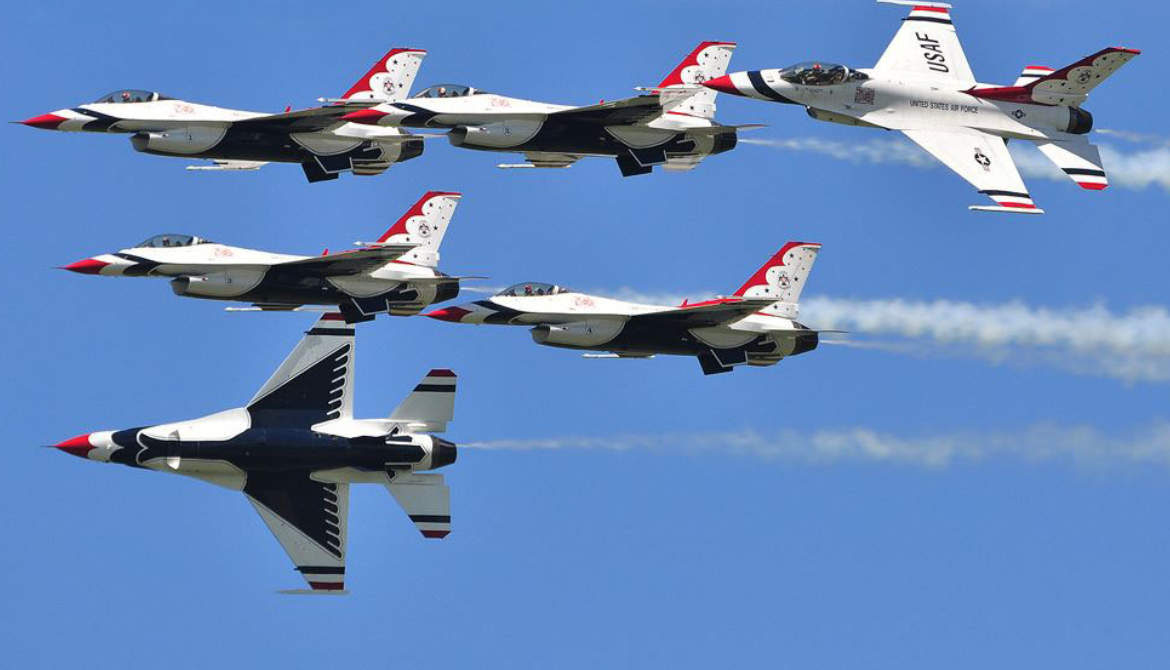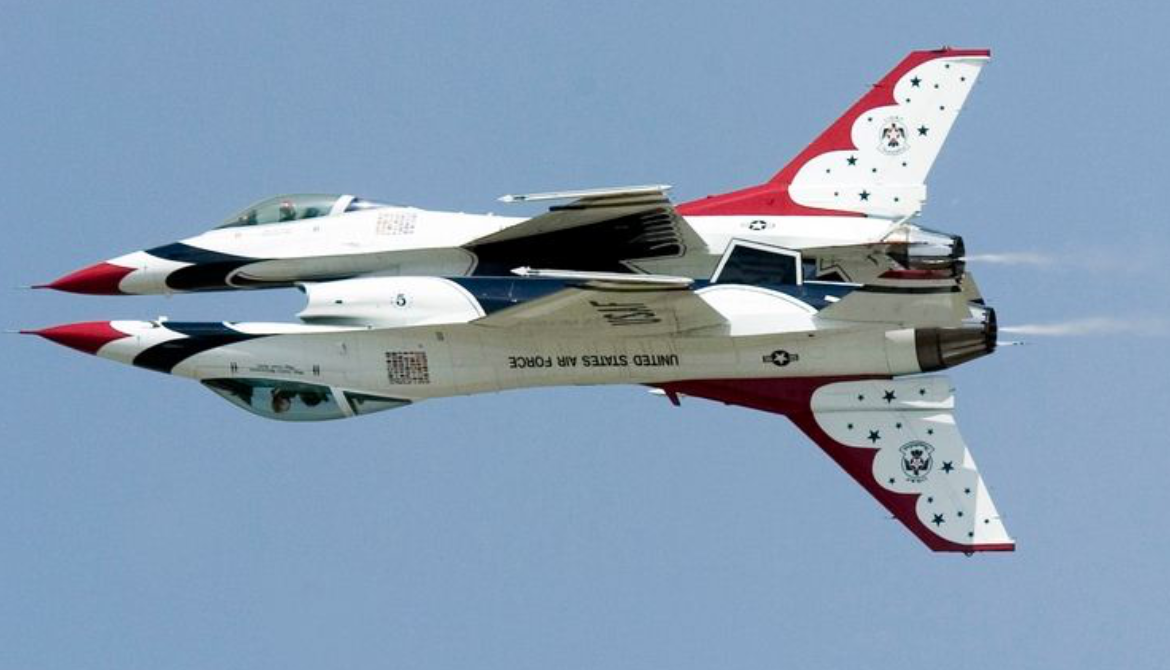
HeadGing 3
Boeing Helicopters Wikipedia link
Heading 6
The USAF Air Demonstration Squadron ("Thunderbirds") is the air demonstration squadron of the United States Air Force (USAF).
Amazing Team Thunderbirds "USAF"
The USAF Air Demonstration Squadron ("Thunderbirds") is the air demonstration squadron of the United States Air Force (USAF). The Thunderbirds are assigned to the 57th Wing, and are based at Nellis Air Force Base, Nevada. Created 70 years ago in 1953, the USAF Thunderbirds are the third-oldest formal flying aerobatic team (under the same name) in the world, after the French Air Force Patrouille de France formed in 1931 and the United States Navy Blue Angels formed in 1946.
Team Thunderbirds "USAF"
The Thunderbirds Squadron is a named USAF squadron, meaning it does not carry a numerical designation. It is also one of the oldest squadrons in the Air Force, its origins dating to the organization of the 30th Aero Squadron, formed at Kelly Field, Texas, on 13 June 1917. Officers serve a two-year assignment with the squadron, while enlisted personnel serve three to four years. As the squadron performs no more than 88 air demonstrations each year, replacements must be trained for about half of the team each year, in order to provide a constant mix of experience. In addition to their air demonstration responsibilities, the Thunderbirds are part of the USAF combat force and if required, can be rapidly integrated into an operational fighter unit. Since 15 February 1974 the Thunderbirds have been a component of the 57th Wing at Nellis AFB. Since 1953, they have flown in front of more than 300 million people
Created in 1960
 United States Air Force Thunderbirds emblem |
|
| Active | 25 May 1953 – present (as air demonstration squadron)13 June 1917 – 1 February 1963(as operational squadron) |
|---|---|
| Country | |
| Branch | United States Air Force |
| Role | Aerobatic display team |
| Size | 12 officers132 enlisted support personnel3 civilian support personnel |
| Aircraft flown | |
| Fighter | six F-16C Fighting Falcons two F-16D Fighting Falcons |
|
|
||
|
||
|---|---|---|
Team Thunderbirds "USAF"
Aerobatic Team Thunderbirds.
Aerobatic Team Thunderbirds.)
General Dynamics F-16A/B Fighting Falcon During the switch to the F-16A the Thunderbirds acquired new block 15 aircraft which they operated from 1983 to 1991, making the team one of the last USAF units flying the older F-16A's before transitioning into new C's. They also operated the two-seat F-16B during this time for training new pilots and for VIP flights, these being replaced by the F-16D when the rest of the squadron transitioned to the F-16C.
Lockheed Martin F-16C/D Fighting Falcon (Block 32) The block 32H/J aircraft currently assigned to the Thunderbirds were built in 1986 and 1987, and operated by the Thunderbirds from 1992 to 2008. At their retirement, they were some of the oldest operational F-16s in the Air Force.
Lockheed Martin F-16C/D Fighting Falcon (Block 52) In the 2009 show season the Thunderbirds transitioned to an updated version of the F-16 fighter. The Block 52s have an upgraded avionics package that brings the Thunderbird fleet into alignment with the rest of the worldwide F-16 fleet. Additionally, the more powerful Pratt & Whitney F100-PW-229 engine adds an additional 3,600 lbf of thrust.
This in turn increases the maximum allowable gross weight for ground handling,
taxi, takeoff and in-flight maneuvers by nearly 5,000 lb.
History
Demonstration routine The Thunderbirds perform the Diamond Pass-In-Review at the Aviation Nation airshow at Nellis AFB, NV on November 6, 2022. From the end of the runway the four-ship Thunderbird team get ready to begin their takeoff roll with the words "Thunderbirds, let's run em up!" being retransmitted from the team leader's mic through the PA system for the crowd to hear. Diamond: Historically, as Thunderbirds 1 through 4 lift off, the slot aircraft slips immediately into position behind 1 to create the signature Diamond formation. Thanks to the 2009 upgrade to the Block 52, the Diamond now has more than enough thrust to continue to climb straight up into their first maneuver, the Diamond Loop. Solos: Thunderbird 5 takes to the air next, performing a clean low altitude aileron roll, followed by 6 who performs a split S, climbing in a near vertical maneuver, rolling over and diving back toward show center and pulling up just above the runway to exit in the opposite direction.
Photo Gallery
Team Thunderbirds USA "USAF"
USAF aircraft
The The U.S. War Department created the first antecedent of the U.S. Air Force, as a part of the U.S. Army, on 1 August 1907.
The United States Air Force (USAF) is the air service branch of the United States Armed Forces, and is one of the eight uniformed services of the United States. Originally created on August 1, 1907 as a part of the United States Army Signal Corps, the USAF was established as a separate branch of the United States Armed Forces in 1947 with the enactment of the National Security Act of 1947. It is the second youngest branch of the United States Armed Forces[a] and the fourth in order of precedence. The United States Air Force articulates its core missions as air supremacy, global integrated intelligence, surveillance and reconnaissance, rapid global mobility, global strike, and command and control.
Aircraft In service
Attack A-10, AC-130, MQ-9 Reaper
Bomber B-1B Lacer, B-2, B-52H
Electronic warfare E-3, E-4, E-8, E-9A, E-11A, EC-130H, EC-130J, EQ-4B
Fighter F-15C/D, F-15E, F-15EX, F-16C/D, F-22, F-35A
Helicopter CV-22, HH-60, MH-139, UH-1N
Reconnaissance CN-235, MC-12, RC-135S/U/V/W, RC-26B,
Trainer A-29, T-1, T-6, T-38, T-41, T-51, T-53, TG-16, TH-1
Transport C-5M Galaxy, C-12, C-17, C-20, C-21, C-32, C-37, C-40, Lockheed C-130 Hercules,
Tanker KC-10, KC-135, KC-46, HC-130, MC-130
Boeing Logo
Boeing Rotorcraft Systems (formerly Boeing Helicopters and before that Boeing Vertol)

Boeing CH46 Seaknight
Boeing Vertol CH-46 Sea Knight is an American medium-lift tandem-rotor helicopter.

Boeing MV-22 Osprey
Bell Boeing V-22 Osprey is an American multi-mission, tiltrotor military aircraft



Lockheed / Martin aircraft
F-16 block 32+ MLU Fighting Falcon
About
F-16 MLU Falcon
-
Role Multirole fighter, air superiority fighter National origin United States Manufacturer - General Dynamics (1974–1993)
- Lockheed Corporation (1993–1995)
- Lockheed Martin (1995–present)
First flight
-
First flight - 20 January 1974; 48 years ago (unplanned)
- 2 February 1974; 48 years ago (official)
Introduction 17 August 1978; 44 years ago Status In service Produced 1973–2017, 2019–present Number built 4,604 (June 2018)
General Info
- Crew: 1
- Length: 49 ft 5 in (15.06 m)
- Wingspan: (9.96 m)
- Height: 16 ft (4.9 m)
- Wing area: (28 m2)
- Empty weight: (8,573 kg)
- Gross weight:12,020
- Max takeoff weight: 42,300 lb (19,187 kg)
- Payload: 15,800 lb (7,167 kg)[]
- Powerplant: 1 × General Electric F110-GE-129 for Block 50 aircraft
Performance
- Maximum speed: Mach 2.05, 1,176 kn (1,353 mph; 2,178 km/h) at 40,000 feet, clean
- Combat range: 546 km)
- Ferry range: 2,277 nmi (2,620 mi, 4,217 km) with drop tanks
- Service ceiling: (18,000 m)[]
- Guns: 1 × 20 mm (0.787 in) M61A1 Vulcan
- Hardpoints: 2 × wing-tip air-to-air, capacity of up to (7,700 kg)




